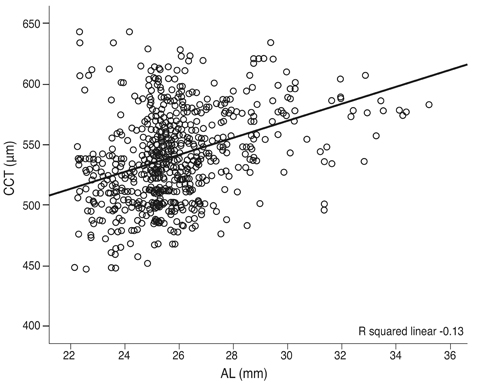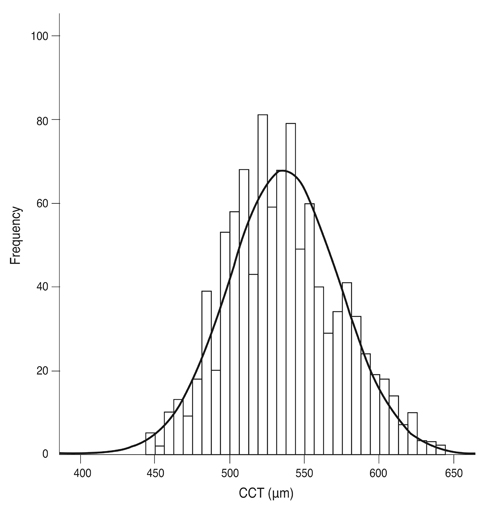Korean J Ophthalmol.
2012 Oct;26(5):324-330. 10.3341/kjo.2012.26.5.324.
Correlations between Magnitude of Refractive Error and Other Optical Components in Korean Myopes
- Affiliations
-
- 1Department of Ophthalmology, St. Mary's Hospital, The Catholic University of Korea School of Medicine, Seoul, Korea. sara514@catholic.ac.kr
- KMID: 1397482
- DOI: http://doi.org/10.3341/kjo.2012.26.5.324
Abstract
- PURPOSE
We evaluated ocular optical components and their interrelationships in myopic Korean patients.
METHODS
In this prospective observational study, 1,011 consecutive patients were recruited from a refractive surgery clinic. The best-corrected visual acuity was >20 / 20 in all patients. The refractive error, axial length (AL), anterior chamber depth (ACD), lens thickness (LT), and vitreous chamber depth (VCD) were measured by an autorefractor and partial coherence laser interferometry (IOL Master). Central corneal thickness (CCT) was measured by ORBscan II topography.
RESULTS
The refractive errors had a positive correlation with LT but negative correlations with AL, ACD, VCD, and CCT. As the axial length increased, the ACD, VCD, and CCT increased but the LT decreased. The CCT had a positive correlation with gender, refractive errors, ACD, VCD, and AL but no correlation with age. The mean CCT was increased in proportion to the increase in AL.
CONCLUSIONS
In myopic Korean patients, as axial elongation progressed, the VCD and ACD deepened and the CCT thickened but the LT decreased. The CCT had a positive correlation with the degree of myopia and the AL.
MeSH Terms
Figure
Reference
-
1. Pesando PM, Ghiringhello MP, Tagliavacche P. Posterior chamber collamer phakic intraocular lens for myopia and hyperopia. J Refract Surg. 1999. 15:415–423.2. Yaylali V, Kaufman SC, Thompson HW. Corneal thickness measurements with the Orbscan Topography System and ultrasonic pachymetry. J Cataract Refract Surg. 1997. 23:1345–1350.3. Shimmura S, Yang HY, Bissen-Miyajima H, et al. Posterior corneal protrusion after PRK. Cornea. 1997. 16:686–688.4. Probst LE, Machat JJ. Mathematics of laser in situ keratomileusis for high myopia. J Cataract Refract Surg. 1998. 24:190–195.5. Ehlers N, Bramsen T, Sperling S. Applanation tonometry and central corneal thickness. Acta Ophthalmol (Copenh). 1975. 53:34–43.6. Doughty MJ, Zaman ML. Human corneal thickness and its impact on intraocular pressure measures: a review and meta-analysis approach. Surv Ophthalmol. 2000. 44:367–408.7. Whitacre MM, Stein RA, Hassanein K. The effect of corneal thickness on applanation tonometry. Am J Ophthalmol. 1993. 115:592–596.8. Wolfs RC, Klaver CC, Vingerling JR, et al. Distribution of central corneal thickness and its association with intraocular pressure: the Rotterdam Study. Am J Ophthalmol. 1997. 123:767–772.9. Brandt JD, Beiser JA, Kass MA, Gordon MO. Central corneal thickness in the Ocular Hypertension Treatment Study (OHTS). Ophthalmology. 2001. 108:1779–1788.10. Osuobeni EP. Ocular components values and their intercorrelations in Saudi Arabians. Ophthalmic Physiol Opt. 1999. 19:489–497.11. Aghaian E, Choe JE, Lin S, Stamper RL. Central corneal thickness of Caucasians, Chinese, Hispanics, Filipinos, African Americans, and Japanese in a glaucoma clinic. Ophthalmology. 2004. 111:2211–2219.12. Shimmyo M, Orloff PN. Corneal thickness and axial length. Am J Ophthalmol. 2005. 139:553–554.13. Kunert KS, Bhartiya P, Tandon R, et al. Central corneal thickness in Indian patients undergoing LASIK for myopia. J Refract Surg. 2003. 19:378–379.14. Von Bahr G. Corneal thickness; its measurement and changes. Am J Ophthalmol. 1956. 42:251–266.15. Alsbirk PH. Corneal thickness. I. Age variation, sex difference and oculometric correlations. Acta Ophthalmol (Copenh). 1978. 56:95–104.16. Chang SW, Tsai IL, Hu FR, et al. The cornea in young myopic adults. Br J Ophthalmol. 2001. 85:916–920.17. Srivannaboon S. Relationship between corneal thickness and level of myopia. J Med Assoc Thai. 2002. 85:162–166.18. Touzeau O, Allouch C, Borderie V, et al. Correlation between refraction and ocular biometry. J Fr Ophtalmol. 2003. 26:355–363.19. Martola EL, Baum JL. Central and peripheral corneal thickness: a clinical study. Arch Ophthalmol. 1968. 79:28–30.20. Hansen FK. A clinical study of the normal human central corneal thickness. Acta Ophthalmol (Copenh). 1971. 49:82–89.21. Cho P, Lam C. Factors affecting the central corneal thickness of Hong Kong-Chinese. Curr Eye Res. 1999. 18:368–374.22. Price FW Jr, Koller DL, Price MO. Central corneal pachymetry in patients undergoing laser in situ keratomileusis. Ophthalmology. 1999. 106:2216–2220.23. Liu Z, Pflugfelder SC. The effects of long-term contact lens wear on corneal thickness, curvature, and surface regularity. Ophthalmology. 2000. 107:105–111.24. Pedersen L, Hjortdal J, Ehlers N. Central corneal thickness in high myopia. Acta Ophthalmol Scand. 2005. 83:539–542.25. Fam HB, How AC, Baskaran M, et al. Central corneal thickness and its relationship to myopia in Chinese adults. Br J Ophthalmol. 2006. 90:1451–1453.26. Lim SJ, Choi O. Interrelationship of the refractory error and the ocular axial length and the anterior chamber depth in the myopic eyes. J Korean Ophthalmol Soc. 1986. 27:371–376.27. Rao SN, Raviv T, Majmudar PA, Epstein RJ. Role of Orbscan II in screening keratoconus suspects before refractive corneal surgery. Ophthalmology. 2002. 109:1642–1646.28. Drexler W, Findl O, Menapace R, et al. Partial coherence interferometry: a novel approach to biometry in cataract surgery. Am J Ophthalmol. 1998. 126:524–534.29. Goss DA, Van Veen HG, Rainey BB, Feng B. Ocular components measured by keratometry, phakometry, and ultrasonography in emmetropic and myopic optometry students. Optom Vis Sci. 1997. 74:489–495.30. Foster PJ, Baasanhu J, Alsbirk PH, et al. Central corneal thickness and intraocular pressure in a Mongolian population. Ophthalmology. 1998. 105:969–973.
- Full Text Links
- Actions
-
Cited
- CITED
-
- Close
- Share
- Similar articles
-
- Choroidal Blood Flow Change in Eyes with High Myopia
- A Study of the Ocular Findings According to Subdivided Myepia
- Relationship between Uncorrected Visual Acuity and Refractive Error in Visual Acuity Test of Children
- Refractive Outcomes of Uneventful Cataract Surgery in Pseudoexfoliation Syndrome and Pseudoexfoliation Glaucoma
- The Variation of Choroidal Thickness and Refractive Error after Cataract Surgery



